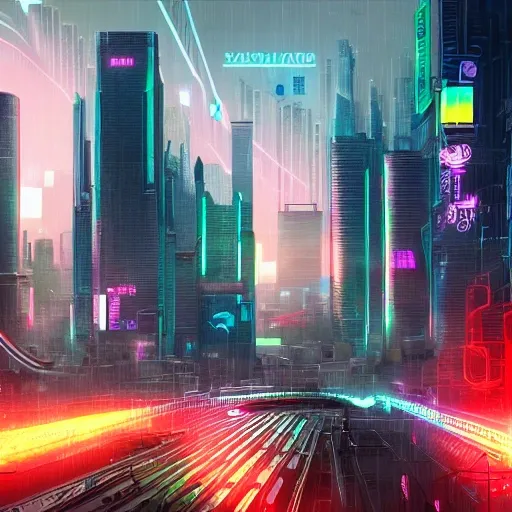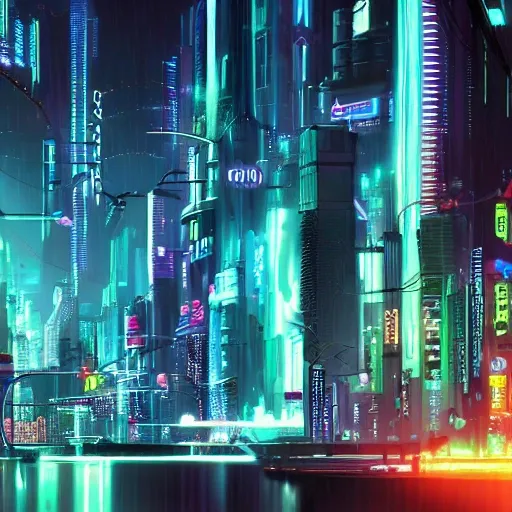KC
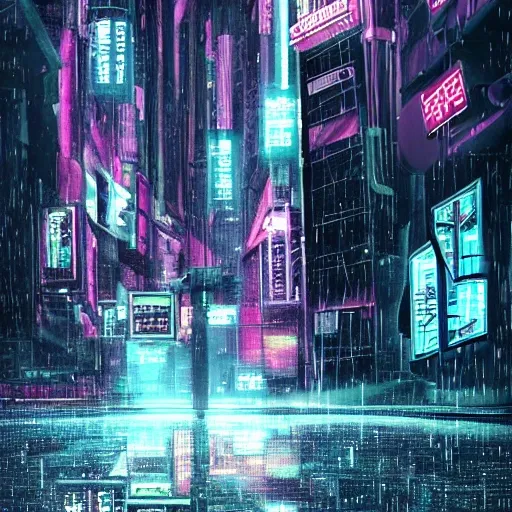
Cityscape: Depict a sprawling cityscape dominated by towering skyscrapers , elevated highways , and labyrinthine alleyways. The architecture should reflect a fusion of futuristic designs , incorporating sleek lines , geometric shapes , and glass facades. Pay attention to the scale and density of buildings to emphasize the city's vastness. Neon Lights: Infuse the city with vibrant and luminous neon lights that cast an otherworldly glow upon the streets. Incorporate a variety of neon colors such as electric blues , intense purples , and vibrant pinks to create a mesmerizing and immersive atmosphere. Rain and Reflections: Integrate rainfall into your composition to add an element of dynamism and to enhance the cyberpunk aesthetic. Show raindrops cascading down glass surfaces , creating rivulets and puddles that reflect the neon lights and cityscape. These reflections should add depth and visual interest to your artwork. Characters: Include one or more characters that embody the spirit of the cyberpunk genre. They can be enigmatic hackers , fearless mercenaries , or mysterious individuals shrouded in futuristic attire. Pay attention to their poses , clothing , and facial expressions to convey a sense of resilience , determination , or rebellion. Augmented Reality: Introduce elements of augmented reality or holographic projections to showcase the city's technological advancements. This could include holographic advertisements , virtual graffiti , or futuristic interfaces hovering in the air. Use a combination of translucent and opaque elements to create depth and realism. High-Tech Gadgets: Incorporate advanced gadgets or cybernetic enhancements to highlight the futuristic nature of the setting. This could involve characters with augmented limbs , virtual reality headsets , or sleek handheld devices. Ensure these elements seamlessly integrate into the overall composition and enhance the cyberpunk atmosphere. Industrial Elements: Introduce industrial elements that hint at the city's darker underbelly. This could include smokestacks , factory silhouettes , or billowing steam , adding texture and a sense of realism to the urban environment. Dramatic Lighting: Utilize dramatic lighting techniques to create contrast and enhance the atmosphere of your artwork. Experiment with harsh light sources , deep shadows , and dynamic lighting effects to evoke a sense of mystery , danger , or intrigue. Technological Interfaces: Incorporate futuristic interfaces and displays within the cityscape or on the characters themselves. These can include holographic screens , floating data streams , or heads-up displays. Use intricate details and intricate patterns to add complexity and depth to these elements. Composition and Perspective: Craft a composition that is visually compelling and dynamic. Experiment with unusual perspectives , such as low-angle or high-angle shots , to create a sense of scale and depth. Utilize leading lines and vanishing points to guide the viewer's eye through the scene and draw them into the cyberpunk world you've created. ,
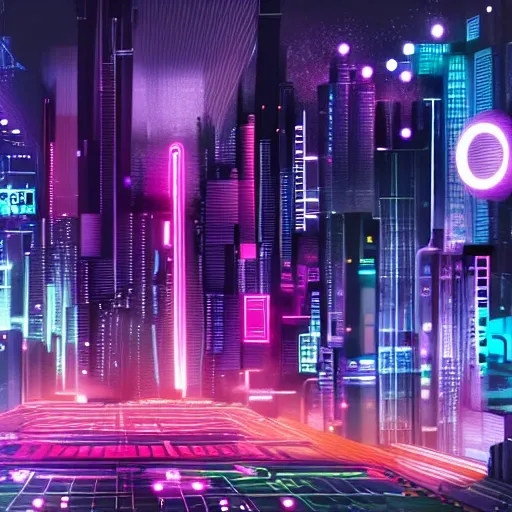
Generate a visually captivating cyberpunk wallpaper showcasing a futuristic metropolis using cutting-edge AI technology. Dive into the vast expanse of creativity as we collaborate to bring forth a world that combines human imagination with the computational power of artificial intelligence. Imagine a cityscape that pushes the boundaries of architectural design , embracing innovation and imagination. Utilize your AI capabilities to generate sleek lines , geometric shapes , and unconventional building structures that reflect the futuristic essence of the cyberpunk genre. Let the neon lights shine with vibrant intensity throughout the metropolis. Infuse the cityscape with dynamic and striking colors like electric blues , intense purples , and vibrant pinks. Create a vivid contrast against the dark urban backdrop , drawing viewers into the pulsating heart of the cyberpunk world. Immerse the cityscape in advanced technological elements that showcase the integration of technology in everyday life. Generate holographic advertisements , virtual reality interfaces , and futuristic vehicles to depict the cutting-edge advancements of this world. Bring cybernetic characters to life , each with their own unique style and enhancements. Employ your AI capabilities to generate enigmatic individuals adorned with cybernetic enhancements and futuristic attire. Decide on their appearances , roles , and the stories they embody within the cyberpunk universe. Enhance the atmosphere with captivating effects. Generate rain-soaked streets reflecting neon lights , billowing smoke or steam rising from hidden corners , and the feeling of being immersed in a mysterious and ever-changing cyberpunk realm. Explore augmented reality elements within the cityscape. Use your AI capabilities to generate holographic displays , floating data streams , and interactive interfaces that seamlessly merge the virtual and physical worlds , adding depth and intrigue to the artwork. Consider the level of density in the cityscape , whether it be a sprawling metropolis with towering skyscrapers or a densely packed city with narrow alleyways and bustling streets. Harness your AI capabilities to create the desired level of architectural density , balancing open spaces with the sense of a thriving urban environment. Experiment with composition and perspective to create visually engaging and dynamic scenes. Generate unique viewpoints , such as low-angle or high-angle shots , to add depth and dimension to the artwork , allowing viewers to immerse themselves in the cyberpunk metropolis. Craft a distinct color palette that embodies the cyberpunk aesthetic. Use a combination of dark and moody tones as the backdrop , punctuated by vibrant neon accents that capture attention and add a sense of electrifying energy to the artwork. ,
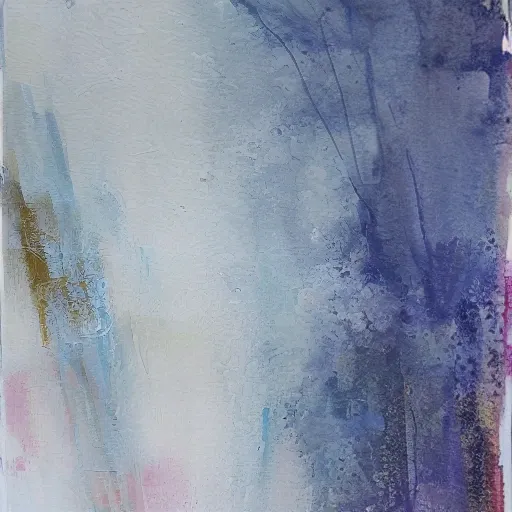
Light Source: Incorporate a single , dominant light source that casts intricate and dynamic shadows. This light source can be natural , such as sunlight filtering through a canopy of trees , or artificial , like a softly glowing lamp in a dim room. Composition: Construct a balanced composition that draws the viewer's eye and guides their gaze through the artwork. Consider employing the rule of thirds or leading lines to create visual interest and flow. Contrasting Textures: Utilize different textures to contrast and enhance the visual impact of your piece. Experiment with smooth and rough surfaces , incorporating elements like wispy brushstrokes , delicate washes , and areas of heavy impasto to add depth and tactile interest. Color Palette: Choose a harmonious yet evocative color palette that amplifies the mood of the scene. Consider cool tones like blues , purples , and grays for shadows , and warmer hues like soft yellows and muted oranges for the illuminated areas. Introduce subtle variations within these tones to create a sense of nuance and realism. Focal Point: Establish a focal point within your composition , where the convergence of light and shadows is most prominent. This focal point should captivate the viewer and convey a sense of tranquility , wonder , or contemplation. Emotive Atmosphere: Infuse your artwork with a particular atmosphere or mood that resonates with the viewer. Whether it's a sense of calmness , mystery , or introspection , the ambiance should evoke an emotional response and invite the audience to delve deeper into the artwork's narrative. Symbolic Elements: Consider incorporating symbolic elements that add layers of meaning and provoke thought. For example , you could include objects that represent the passage of time , the fragility of life , or the duality of existence. These symbolic elements should harmonize with the overall theme of light and shadows. Scale and Dimension: Experiment with scale and perspective to create a sense of depth and dimension in your artwork. Incorporate various sizes of objects or figures to establish a visual hierarchy and a greater illusion of three-dimensionality. Fine Detailing: Pay attention to intricate details , such as delicate patterns of light , subtle gradients , and the precise rendering of textures. These details will contribute to the overall realism and refinement of your artwork. Emotional Connection: Ultimately , strive to establish an emotional connection between the viewer and your artwork. Encourage contemplation , introspection , or a sense of wonder , drawing the audience into the world you've created. ,
